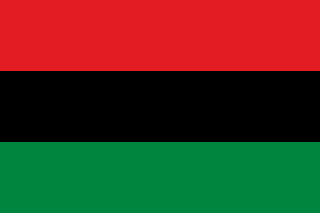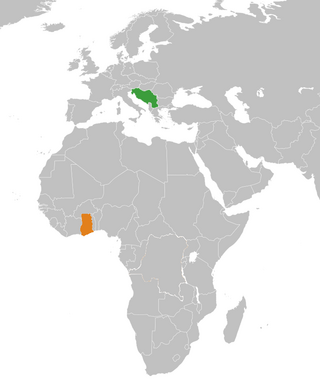
Francis Kwame Nkrumah was a Ghanaian politician, political theorist, and revolutionary. He served as Prime Minister of the Gold Coast from 1952 until 1957, when it gained independence from Britain. He was then the first Prime Minister and then the President of Ghana, from 1957 until 1966. An influential advocate of Pan-Africanism, Nkrumah was a founding member of the Organization of African Unity and winner of the Lenin Peace Prize from the Soviet Union in 1962.

African socialism or Afrosocialism is a belief in sharing economic resources in a traditional African way, as distinct from classical socialism. Many African politicians of the 1950s and 1960s professed their support for African socialism, although definitions and interpretations of this term varied considerably. These politicians include Julius Nyerere of Tanzania, Kwame Nkrumah of Ghana, and Modibo Keita of Mali, among others.

The Union of African States, sometimes called the Ghana–Guinea–Mali Union, was a short-lived and loose regional organization formed in 1958 linking the West African nations of Ghana and Guinea as the Union of Independent African States. Mali joined in 1961. It disbanded in 1963.

For India, the concept of non-alignment began as a policy of non-participation in the military affairs of a bipolar world and in the context of colonialism aimed towards optimum involvement through multi-polar participation towards peace and security. It meant a country should be able to preserve a certain amount of freedom of action internationally. There was no set definition of non-alignment, which meant the term was interpreted differently by different politicians and governments, and varied in different contexts. The overall aims and principles found consensus among the movement members. Non-aligned countries, however, rarely attained the freedom of judgement they desired and their actual behaviour towards the movement's objectives, such as social justice and human rights, were unfulfilled in many cases. India's actions often resembled those of aligned countries. The response of the non-aligned nations during India's wars in 1962, 1965 and 1971 revealed non-aligned positions on issues such as secession. The non-aligned nations were unable to fulfil the role of peacekeepers during the Indo-China war of 1962 and the Indo-Pakistan war of 1965 despite meaningful attempts. The non-aligned response to the Bangladesh Liberation War and the following 1971 Indo-Pakistan War showed most of the non-aligned nations prioritised territorial integrity above human rights, which could be explained by the recently attained statehood for the non-aligned. During this period, India's non-aligned stance was questioned and criticized. Jawaharlal Nehru had not wanted the formalization of non-alignment and none of the non-aligned nations had commitments to help each other. The international rise of countries such as China also decreased incentives for the non-aligned countries to stand in solidarity with India.

Ghana–Hungary relations are the current and historical relations between Ghana and Hungary.

The Socialist Federal Republic of Yugoslavia was one of the founding members of the Non-Aligned Movement. Its capital, Belgrade, was the host of the First Summit of the Non-Aligned Movement in early September 1961. The city also hosted the Ninth Summit in September 1989.

Ghana–Yugoslavia relations were historical foreign relations between Ghana and the Socialist Federal Republic of Yugoslavia. Formal diplomatic relations at the level of Embassy were established in 1959. Both countries were the founding member states of the Non-Aligned Movement at the 1961 Non-Aligned Conference in Belgrade. President of Yugoslavia Josip Broz Tito paid his first State visit to Ghana in 1961, just one year after the full independence of the Dominion of Ghana.
Egypt was one of the founding members of the Non-Aligned Movement (NAM). The preparatory meeting for the First NAM Conference in Belgrade was held in Cairo between 5 and 12 June 1961. The first NAM conference was cosponsored between President of Egypt Gamal Abdel Nasser and President of Yugoslavia Josip Broz Tito who sent joint letter to other leaders during their bilateral meeting in Egypt. Cairo hosted the Second Conference in October 1964 attended by forty-seven countries while Egyptian Red Sea resort Sharm el-Sheikh hosted the Fifteenth Conference in 2009. At the time of the Sharm el-Sheikh Conference 118 countries participated in the activities of the movement with some other countries having the observer status. 55 heads of state attended the 2009 conference. Official Egyptian state institutions view the movement as the broadest and the most important framework for developing countries to coordinate their stances on issues on the agenda of the United Nations and to act together against unilateral policies.
During the Cold War period former Southeast European country of the Socialist Federal Republic of Yugoslavia established and maintained significant political, cultural and economic exchanges and relations with newly independent African states. While majority of multilateral exchanges were organized via Non-Aligned Movement and the United Nations, significant cooperation developed with the Organisation of African Unity as well, predecessor to contemporary African Union. Yugoslavia was the only non-African country which participated in funding of the Liberation Committee of the Organisation of African Unity. While being a uniquely involved in the workings of the body the country nevertheless preferred bilateral relations with individual liberation movements. The Organisation of African Unity included the Non-Alignment principle in its charter while Yugoslavia consider the organisation to be the only legitimate representative for the entire African continent throughout the Cold War era. Yugoslavia therefore followed common OAU line in its own policies towards issues in Africa.

Summit Conference of Heads of State or Government of the Non-Aligned Movement on 1–6 September 1961 in Belgrade, Yugoslavia was the first conference of the Non-Aligned Movement. A major contributing factor to the organization of the conference was the process of decolonization of a number of African countries in the 1960s. Some therefore called it the ″Third World's Yalta″ in reference to 1945 Yalta Conference.

Third Conference of the Non-Aligned Movement on 8–10 September 1970 in Lusaka, Zambia was the third conference of the Non-Aligned Movement. A preparatory meeting of Foreign Ministers drafted a number of resolutions which were considered by the Summit Conference. President of Zambia Kenneth Kaunda opened the conference by underlining non-alignment as "the natural choice at the time of increased hostility created by ideological conflicts in the bipolar world"

The Non-Aligned Movement (NAM) is a forum of 120 countries that are not formally aligned with or against any major power bloc. It was founded with the view to advancing interests of developing countries in the context of Cold War confrontation. After the United Nations, it is the largest grouping of states worldwide.
Second Summit Conference of Heads of State or Government of the Non-Aligned Movement on 5–10 October 1964 in Cairo, United Arab Republic (Egypt) was the second conference of the Non-Aligned Movement which followed the Belgrade Conference of 1961 and preceded the Lusaka Conference of 1970. The city of Cairo was selected as a host of the summit conference at the preparatory meeting held in Colombo, Ceylon, on March 23, 1964. At the beginning of the conference the chairmanship of the Movement was transferred from the President of Yugoslavia Josip Broz Tito to the President of Egypt Gamal Abdel Nasser.

The 9th Summit of the Non-Aligned Movement on 4–7 September 1989 in Belgrade, SR Serbia, SFR Yugoslavia was the conference of Heads of State or Government of the Non-Aligned Movement. Belgrade was the first city to host the Summit for the second time after it hosted the 1st Summit of the Non-Aligned Movement in 1961. Yugoslavia was unanimously selected as the host of the Summit at the 1988 Non-Aligned Foreign Ministers Conference in Nicosia, Cyprus. While the Federal Secretary of Foreign Affairs of Yugoslavia led by Budimir Lončar was excited, the Presidency of Yugoslavia, Yugoslav collective head of state, was skeptical about the prospects of hosting the event but ultimately supported it by Josip Vrhovec in fear that rejection may show the level of the crisis in the country. The comparatively weak federal government organizers of the event ultimately hoped that the conference may convince leaders of the strong Yugoslav federal republics to resolve the early Yugoslav crisis in a constructive and peaceful way, yet it nevertheless escalated in 1991 Yugoslav Wars. The event is therefore sometimes described as the swan song of the prominent Yugoslav Cold War diplomacy. Summit took place at the Sava Centar in New Belgrade. Janez Drnovšek held the opening remarks in Slovenian language.

10th Summit of the Non-Aligned Movement on 1–6 September 1992 in Jakarta, Indonesia was the conference of Heads of State or Government of the Non-Aligned Movement. Around 100 delegations, including some 60 heads of State or government, participated in the Summit in Jakarta.
1969 Non-Aligned Movement Consultative Meeting took place in Belgrade, SR Serbia, SFR Yugoslavia on 8–12 July following the Warsaw Pact invasion of Czechoslovakia in August 1968. Non-interventionism was put on the top of the agenda by the host nation while the discussion over the national liberation caused some divisions with Algeria requesting their full participation but only Palestine Liberation Organization being granted the right to participate on equal footing. Algeria in turn blocked Yugoslav proposal to admit countries formally aligned in military pacts but pursuing policy close to non-alignment such as the Socialist Republic of Romania and Czechoslovak Socialist Republic which tried to distance themselves from Soviet led Warsaw Pact and Malaysia, Singapore, Tunisia and Pakistan most of which were part of Western led Baghdad Pact or Southeast Asia Treaty Organization.
1961 Preparatory Meeting of the Non-Alignment Countries was held in Cairo, United Arab Republic from 5 to 12 June 1961 to discuss the goals of a policy of nonalignment ahead of the 1st Summit of the Non-Aligned Movement which will take place in September of the same year in Belgrade, SFR Yugoslavia. The goal of the meeting was to set common criteria for attendance at the Belgrade Conference with Cairo attendees division into two fractions of “inclusives” led by Nehru's government of India and “exclusives” led by the Casablanca Group. Group led by India wanted for future summit to welcome neutral countries in Europe and if feasible multiple Latin American countries and for the event to focus on what was perceived by Indian representatives as grand and overarching issues of global consequence instead of more parochial concerns. Cuban and Guinean representatives were dominant in the “exclusives” group which wanted to focus on the issue of decolonization and criticism of the West Bloc.
Sri Lanka is one of the founding members of the Non-Aligned Movement. Principles of Non-Alignment and participation in movement's activities is of high priority in foreign policy of the country.

The 19th Summit of the Non-Aligned Movement was held in January 2024 in Kampala, Uganda. Out of 120 member states around 90 participated in the summit including 30 heads of state. The event was marked by strong criticism of Israel's actions during the Israel–Hamas war by many participating delegations. It was the first time since 2009 that the NAM summit was organized in Africa and first time since 1998 (Durban) it was organized in Sub-Saharan Africa.
Tanzania is an active and prominent member state of the Non-Aligned Movement since the days of independence of Tanganyika in 1961. In early days of the movement President Julius Nyerere was recognized as one of the leading figures in the movement and among Third World leaders in general. His government promoted close adherence to non-alignment principles in which Global North and Global South division was more important than Cold War East–West dichotomy, supported African cooperation, engaged in a strong criticism of superpower intrusion in African affairs and supported the establishment of the New International Economic Order.













